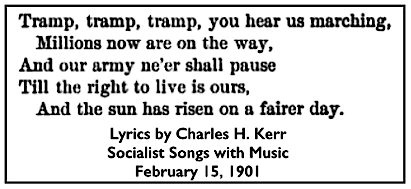 —————
—————
Hellraisers Journal – Sunday July 28, 1901
San Francisco, California – Teamsters Strike on Waterfront Cripples City
From The San Francisco Call of July 23, 1901:
 —————
—————
Hellraisers Journal – Sunday July 28, 1901
San Francisco, California – Teamsters Strike on Waterfront Cripples City
From The San Francisco Call of July 23, 1901:
 —————
—————
Hellraisers Journal – Thursday May 18, 1911
“The General Strike” -from Speech by Big Bill Haywood, Part II
From the International Socialist Review of May 1911:
[Part II of II]
And in Wales it was my good fortune to be there, not to theorize but to take part in the general strike among the coal miners. Previous to my coming, or in previous strikes, the Welsh miners had been in the habit of quitting work, carrying out their tools, permitting the mine managers to run the pumps, allowing the engine winders to remain at work, carrying food down to the horses, keeping the mines in good shape, while the miners themselves were marching from place to place singing their oldtime songs, gathering on the meeting grounds of the ancient Druids and listening to the speeches of the labor leaders; starving for weeks contentedly, and on all occasions acting most peaceably; going back to work when they were compelled to by starvation.
But this last strike was an entirely different one. It was like the shoemakers’ strike in Brooklyn. Some new methods had been injected into the strike. I had spoken there on a number of occasions previous to the strike being inaugurated, and I told them of the methods that we adopted in the west, where every man employed in and around the mine belongs to the same organization; where when we went on strike the mine closed down. They thought that that was a very excellent system. So the strike was declared. They at once notified the engine winders, who had a separate contract with the mine owners, that they would not be allowed to work. The engine winders passed a resolution saying that they would not work. The haulers took the same position. No one was allowed to approach the mines to run the machinery.
Well, the mine manager, like mine managers everywhere, taking unto himself the idea that the mines belonged to him, said, “Certainly the men won’t interfere with us. We will go up and run the machinery.” And they took along the office force. But the miners had a different notion and they said, “You can work in the office, but you can’t run this machinery. That isn’t your work. If you run that you will be scabbing; and we don’t permit you to scab-not in this section of the country, now.” They were compelled to go back to the office. There were 325 horses underground, which the manager, Llewellyn, complained about being in a starving condition. The officials of the union said, “We will hoist the horses out of the mine.” “Oh, no, we don’t want to bring them up. We will all be friends in a few days.”
 —————
—————
Hellraisers Journal – Wednesday May 17, 1911
“The General Strike” -from Speech by Big Bill Haywood
From the International Socialist Review of May 1911:
[Part I of II]
Comrades and Fellow-Workers:
I came tonight to speak to you on the general strike. And this night, of all the nights in the year, is a fitting time. Forty years ago today there began the greatest general strike known in modern history, the French Commune; a strike that required the political powers of two nations to subdue, namely, France and the iron hand of a Bismarck government of Germany. That the workers would have won that strike had it not been for the copartnership of the two nations, there is to my mind no question. They would have overcome the divisions of opinions among themselves. They would have re-established the great national workshops that existed in Paris and throughout France in 1848. The world would have been on the highway toward an industrial democracy, had it not been for the murderous compact between Bismarck and the government of Versailles.
We are met tonight to consider the general strike as a weapon of the working class. I must admit to you that I am not well posted on the theories advanced by Jaures, Vandervelde, Kautsky and others who write and speak about the general strike. But I am not here to theorize, not here to talk in the abstract but to get down to the concrete subject of whether or not the general strike is an effective weapon for the working class. There are vote-getters and politicians who waste their time coming into a community where 90 per cent of the men have no vote, where the women are disfranchised 100 per cent and where the boys and girls under age of course are not enfranchised. Still they will speak to these people about the power of the ballot, and they never mention a thing about the power of the general strike.
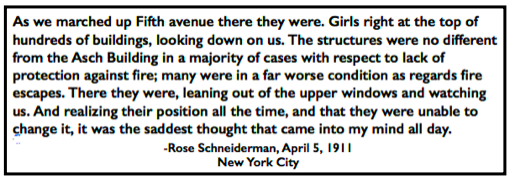 ———-
———-
Hellraisers Journal – Thursday May 4, 1911
Louis Duchez on Murder of Shirtwaist Makers in New York City, Part II
From the International Socialist Review of May 1911:
THE MURDER OF THE SHIRT WAIST MAKERS
IN NEW YORK CITYBY LOUIS DUCHEZ
Photographs by American Press Ass’n.
[Part II of II.]
Violations of the law? Yes, enough to hang half a dozen rich exploiters and politicians. But these men won’t hang.
The owner of the building claimed he lived up to the letter of the law. So did the owners of the shirtwaist concern, Blanck and Harris. They blame the city officials. The State Commission of Labor also blames the city officials. On the other hand, the city officials are hunting for someone to point to. One of these gentlemen divides the guilt between God and the “public conscience.”
The more important facts, however, are as follows: While the holocaust was taking place the superintendent of public buildings, Rudolph P. Miller, was on a pleasure trip to Panama. Under questioning conducted by Fire Marshal Beers he admitted that the Asch building, in which the fire took place, had not been inspected since it was built, ten years ago. He said he was not even sure that he passed on the building before it was occupied. Miller is not an architect; he is simply a civil engineer-with a “pull.” In his testimony he also admitted that he knew of “graft” from building owners being accepted by inspectors. Miller blamed the police department.
According to the state law, “fire-proof” buildings need not put up more than one fire escape. And that’s all the Asch building had. And this one was useless. When the flames heated the flimsy iron work. it bent like wire. Besides, the scaling ladders were not fit to use and the extension ladders reached only to the 6th floor. The hose, too, was rotten, and the fire apparatus was only so in name. Then iron shutters blocked the fire escape, such as it was.
The locked doors have been mentioned. There was no fire escape to the roof. The machines were so closely packed together, in order to save space. that a panic resulted when the fire first started. Large piles of combustible goods obstructed every aisle and opening, also, if the building and conditions had been deliberately planned for the cremation of human beings, it could not have been more perfect.
To look at the Asch building since the fire one could not tell from the outside that anything had happened to it, were it not for the broken windows. As a matter of fact, the damage only reached $5,000. Everything was insured-but the slaves.
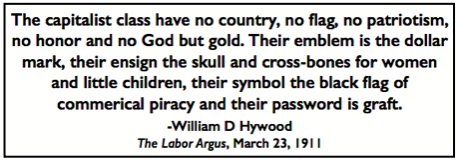 —————
—————
Hellraisers Journal – Friday March 24, 1911
“Organize on the Job Where You Are Robbed”
From the Spokane Industrial Worker of March 23, 1911:
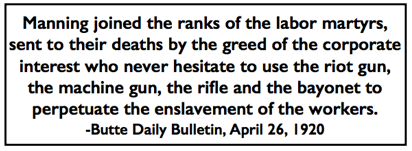 ———-
———-
Hellraisers Journal – Tuesday April 27, 1920
Butte, Montana – Fellow Worker Thomas Manning Dies
From The Butte Daily Bulletin of April 26, 1920:
—–
M’CARTHY AND SULLIVAN HOVERING ON BORDER
OF DEATH IN LOCAL HOSPITAL
———-In the early hours of yesterday morning the spirit of Thomas Manning, first of the victims of the bloodlust of the Anaconda Copper Mining company’s gunmen as evidenced in the massacre of last Wednesday on Anaconda Road, fled to join the spirits of those who at Ludlow, and at other industrial centers of the United States have offered up their lives on the altar of devotion to the cause of the wage slaves.
On a cot in St. James hospital James Sullivan, with his spine shattered by a bullet from one of the company assassins and the lower part of his body paralyzed, lies awaiting the call of the Angel of Death. On another cot in the same institution, John McCarthy, his lungs riddled with shot fired by the murderers of Manning, also awaits the call and is hourly expected to join Manning in the Great Beyond.
Manning joined the ranks of the labor martyrs, sent to their deaths by the greed of the corporate interest who never hesitate to use the riot gun, the machine gun, the rifle and the bayonet to perpetuate the enslavement of the workers, at about 1:30 o’clock yesterday morning. Despite the severity of his wounds and the frequency of internal hemmorhage the merciful administration of opiates by the hospital authorities made his last hours on comparatively painless, although his tortured body tossed and turned in the delirium of approaching death.
The name of Manning, first of the martyrs of Wednesday, the twenty-first, has been emblazoned on the scroll of organized labor in Montana and from reports reaching Butte from the various organizations of workers throughout the state, “Manning!” will be the shibboleth around which the wage slaves will rally to end forever the reigns of the copper, the lumber, the power and the railroad kings in Montana.
 ———-
———-
Hellraisers Journal – Tuesday April 13, 1920
Leavenworth, Kansas – Prison Poem by H. Austin Simons
From The Liberator of April 1920:
From The Liberator of July 1919
-“Try the Big One” by Maurice Becker:
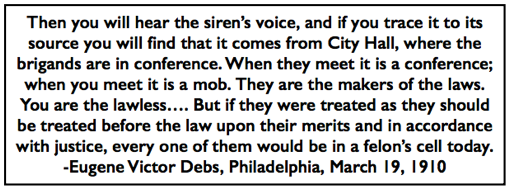 ———-
———-
Hellraisers Journal – Monday April 4, 1910
Philadelphia, Pennsylvania – “When the Sleeper Wakes” by Joseph E. Cohen, Part II
From the International Socialist Review of April 1910:
—–
[Part II of II.]
On February 23rd, Mayor Reyburn dispatched a telegram to Governor Stuart, asking for the state constabulary, or cossacks, as they are more popularly known. Four companies of them, 158 men all told, arrived next day and remained until March 1st.
Now, the people of Philadelphia had no particular quarrel with the state constabulary. Their antipathy was confined largely to the transit company and its strike breakers. To fight against the cossacks meant to engage in bloody warfare, not with fists or bricks, but guns, and this the people were not prepared to do. Were it otherwise, the handful of cossacks would never have left Philadelphia alive. So, aside from a drubbing administered to a few of their number, they were permitted to depart in peace.
—–
 ———-
———-
Hellraisers Journal – Sunday April 3, 1910
Philadelphia, Pennsylvania – “When the Sleeper Wakes” by Joseph E. Cohen, Part I
From the International Socialist Review of April 1910:
—–
[Part I of II.]
CHILD does not blossom into maturity in a day, nor can a weakling to transformed into a Hercules over night. It requires the lapse of many years in the one instance as in the other. And several decades may pass before a city or a nation attains its majority. Yet there is no telling for how long a time the elements have been gathering for some mighty upheaval; how soon, when the surface of things seemed as calm as ever, there would break out an eruption such as would rearrange all that seemed stable and permanent.
Philadelphia is the third city, in population, in America. It has its own peculiar makeup, fondles its own brand of conservatism and will have to work out its own method of salvation from the condition of “corruption and contentment” which has been ascribed to it.
It is a city of “magnificent distances.” That, of itself, explains a great deal, for solidarity and separation are usually antithetical, and Philadelphia is spread over such a wide territory, that people who work and live in Manayunk, Chestnut Hill, Germantown, Olney, Fox Chase, Frankford and Bridesburg—all within the city limits—come down to the center of the city much as country folk go “into town.” Many wage-workers in these localities have had no notion at all of what a trades union is. The seeds of class feeling were only beginning to be scattered among them, their outlook was for all the world, that of some fair sized village—not of the third city in America.
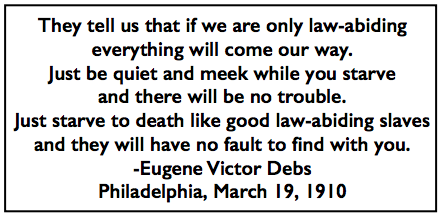 ———-
———-
Hellraisers Journal – Friday April 1, 1910
Philadelphia, Pennsylvania – General Sympathetic Strike Called Off
From The Philadelphia Inquirer of March 28, 1910:
GENERAL STRIKE DECLARED OFF
—–
Lively Debate Accompanies Passage of
Central Labor Union Resolution
—–
Political Movement Recently Launched Also
Discussed at Length-Plans for Carmen
—–
Interest in the trolley strike, so far as organized labor was concerned, centered yesterday in the meeting of the Central Labor Union at its headquarters at 232 North Ninth street.
As expected, the Central Labor Union, upon recommendation of the General Strike Committee of Ten, formally declared the general sympathetic strike off and ordered all union workers to return to their employment this morning, with instructions to continue their moral and financial support of the striking street carmen.
Delegates of the Central Labor Union had considerable to say about cases in which employes who had taken part in the general strike would not be reinstated in their positions by their employers. It was decided to refer all such cases to the Grievance Committee of the Central Labor Union.
There were some warm incidents in the session, particularly when delegates tried to explain why their unions had not participated in the general strike and when the movement for the projected new political labor party was in debate.
A resolution offered by a delegate of the Pressmen’s Union, No. 16, evoked a motion which was passed, from Tobias Hall, representing textile workers, that the resolution should be tabled and the union notified that the Central Labor Union had no use for unions that did not take part in the labor movement.
Then a delegate of the milk wagon drivers’ organization tried in vain to offer an explanation of the failure of his constituents to join the sympathetic walkout.
President John J. Murphy, of the Central Labor Union, instructed Secretary Charles Hope to read the resolution recently passed by the Central Labor Union to the effect that every union that did not go on strike would be regarded, as “working against our best interests.”